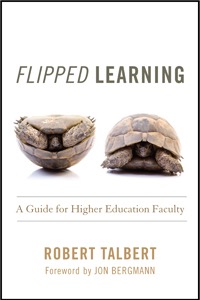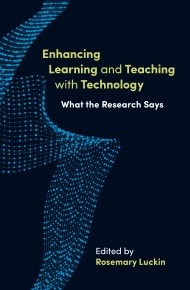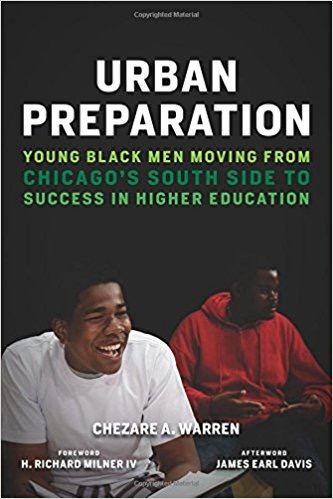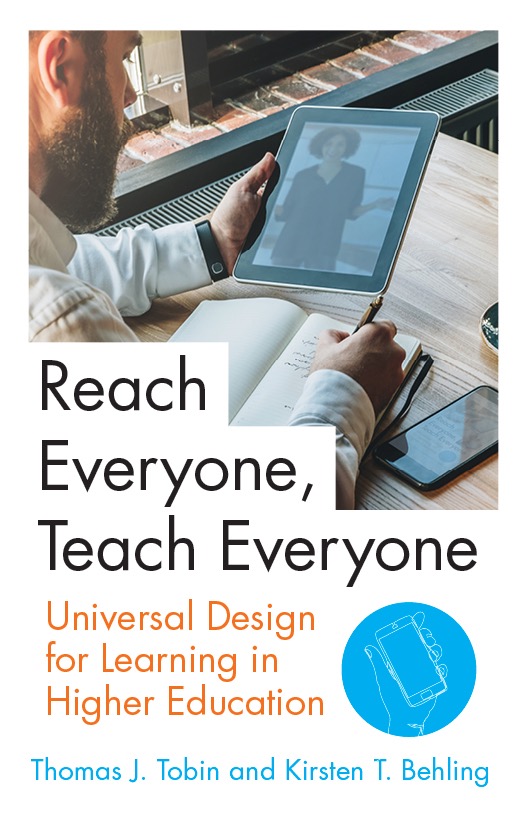student learning
Select an item by clicking its checkbox

Flipped Learning - A Guide for Higher Education Faculty
Date Reviewed: April 6, 2018
Talbert uses his initial chapter, “What Is Flipped Learning, and Why Use It,” to work through definitions and misunderstandings of flipped learning. While flipped learning is commonly believed to consist of assigning videos of lectures for students to watch before class time, Talbert explains that flipped learning is a methodology rather than a specific technique. Flipped learning, he asserts, aims to ensure that students first encounter the new material on their own, outside of class, and then work to nuance their understanding and build skills around that material in the classroom. In this way, students develop the ability to access new material independently and then do the more challenging work of integrating and developing that information in the classroom with assistance from both classmates and the professor, or “expert.” The second chapter, “The History and Theory of Flipped Learning,” traces the method’s history to establish that it is neither new nor a fly by night fad, but rather a sensible pedagogical strategy built on a solid base.
Chapter three, “Models of Flipped Learning,” offers a range of examples from math, business, and economics to demonstrate flipped learning approaches. In each example, Talbert draws from largely mathematics-based courses, suggesting that students read and watch videos about concepts before coming to class to work together on problem sets, the opposite of a traditional STEM course in which concepts are introduced in lecture and students then depart to work on problem sets on their own. (It is noteworthy that although Talbert argues in the earlier chapters that flipped learning is more than watching videos before class, this is, in fact, a primary method that he demonstrates.)
As a religious studies professor, it was hard to see how this method would change the basic format of my humanities classes, in which student read material ahead of time, usually guided by discussion questions, and then come to class for a brief lecture that fills in details and group conversations or a class discussion, informed by their reading. While I have no objection to a book providing instruction on pedagogy for the STEM/business classroom, Talbert’s apparent inability to acknowledge the different structure of the humanities is significant. In failing to recognize that his methods would not significantly change the traditional structure of humanities classes, he has failed to properly acknowledge his book’s disciplinary scope and to correctly identify the audience to whom it would be the most useful. In these fields, flipped learning makes a notable difference from traditional pedagogical methods in which students first encounter new concepts in class. In the humanities, however, students traditionally encounter new material through reading assignments before class. That material is then elaborated upon and explored in classroom lectures, discussions, small groups, and activities. It is difficult, even with one or two humanities-based examples, to see how Flipped Learning dramatically would change my humanities classroom.
Chapters four, five, and six address the nuts and bolts of how to flip a class. Here, Talbert offers both many more specific guidelines and, in a couple of instances, he draws examples from the humanities classroom. For instance, in chapter four, he suggests providing students with a list of reading questions that guide students toward increased complexity of thinking, gradually moving from reading comprehension and synthesis questions to conceptual and analytic questions. Chapter five offers insight into how to construct the activities. Throughout this chapter, Talbert offers cogent summaries of key theories on learning and course design, and while he rarely suggests a technique with which I am unfamiliar, his explanations of how and why they are effective are certainly likely to help me refine my technique.
Chapter seven provides adaptations to the flipped learning model, primarily for low technology educational environments. It also addresses a number of student objections to the flipped classroom, ranging from student complaints about having to teach themselves to gripes that flipped learning takes too much time outside of class. On a practical note, Talbert also addresses the risks of participating in a flipped-learning classroom while untenured or in a contingent position. In each of these situations, he offers concrete advice for mitigating the risk of pedagogical experimentation, particularly reactions from students who are adjusting to a new line of teaching. These chapters were, perhaps, the most useful, as they provided language for addressing student dissatisfaction with new methods and were, perhaps, the most applicable to non-mathematically oriented classrooms.
Throughout the book, I was struck by Talbert’s dry tone. Although I am accustomed to academic writing I found this to be a bit of a slog, which is a less than ideal model for a book dedicated to methods of teaching and learning. More importantly, while the author claims the book will be useful for all of the divisions of higher education, it is constrained by the author’s primary orientation and expertise, and most (though not all) of his examples are drawn from STEM, business, and mathematically oriented social sciences such as economics. Nonetheless, Talbert provides background research that will allow readers to refine and justify some of their existing techniques, helping them engage student learning both within the classroom and beyond it.

Enhancing Learning and Teaching with Technology: What the Research Says
Date Reviewed: September 6, 2018
Rosemary Luckin, editor
London, UK: UCL Institute of Education Press, 2018 (xxxv + 334 pages, ISBN 978-1-78277-226-2, $41.95) The overarching conclusion one might draw from this research-oriented review of current studies regarding education and technology is that we simply do not know enough about the effects of digital resources on teaching and learning. As the authors of this edited ...
Enhancing Learning and Teaching with Technology: What the Research Says
Rosemary Luckin, editor
London, UK: UCL Institute of Education Press, 2018 (xxxv + 334 pages, ISBN 978-1-78277-226-2, $41.95)
The overarching conclusion one might draw from this research-oriented review of current studies regarding education and technology is that we simply do not know enough about the effects of digital resources on teaching and learning. As the authors of this edited volume repeatedly point out, media reports about educational technology typically highlight negative findings and ignore positive associations. Technology champions and detractors rely primarily on face-value benefits or concerns in making their cases for or against educational use. Few studies have empirically considered the interplay among specific learning theories, educational contexts, embodied practices, and various technologies that might enhance learning. Without such research, we cannot draw defensible conclusions about the educational effectiveness of technology resources for formal and informal learning.
Organized in six parts – two that focus on learning factors and four related to educational challenges that might benefit from technological resourcing – the text is at times jargon heavy, particularly for readers unfamiliar with computer programming lingo or European educational policies and practices. A six-page glossary offsets some of this difficulty. Diagrams described as color-coded are printed in black and white, which complicates interpretation. Chapters are short (averaging seven or eight pages), so topics are covered succinctly with little detail to bolster analytic claims. Seven evidence-based learning principles are introduced (2-8) and referenced throughout the text, as are a list of nineteen learning approaches (see Table 2.1, 36). These frameworks serve to tie different case studies together. At the end of each section, the editor summarizes key findings in a bulleted list that can serve as a quick reference for readers.
The case studies provided focus primarily on school-age children and Science, Technology, Engineering, and Math (STEM) subjects or language development, although some chapters address adult learners. Most helpful for Reflective Teaching readers would be the discussions of video production recommendations (chapter 2.4), location-triggered learning (chapter 2.5), gaming and unintentional learning (chapter 3.1), digital access and cheating (chapter 3.2), engaging learning environments (chapter 3.3), and the use of tablets and smartphones in education (chapter 4.2). For those interested in assessment and professional development issues, the last section of the text covers learning analytics and technology-enhanced coaching for teachers. Readers in institutions experimenting with Massive Open Online Courses (MOOCs) might find the presentation of MOOC development priorities (chapter 5.2) useful as a discussion resource in policy-making conversations.
On a more general education level, the short discussion of self-testing and the value of asking students to indicate how certain or uncertain they are about their answers as a strategy to encourage self-reflection on learning (chapter 1.2) may prompt educators to consider whether right answers are sufficient measures of deep knowledge acquisition. Institutional assessment plans often seek to ascertain how well students are integrating and transferring knowledge from one context to another, which depends on deeper forms of understanding. Using this chapter to spark departmental or faculty-wide conversation about what constitutes deep, transferable knowledge could inform assessment design work as well as individual course grading schemes.
Date Reviewed: June 16, 2021
This is also a perfect model for Universal Design for Learning (UDL), a ...
This is also a perfect model for Universal Design for Learning (UDL), a framework grounded in the neuroscience of why, what, and how people learn. Tobin and Behling show that, although it is often associated with students with disabilities, UDL can be profitably broadened toward a larger ease-of-use and general diversity framework. Captioned instructional videos, for example, benefit learners with hearing impairments but also the student who worries about waking her young children at night or those studying on a noisy team bus.
Reach Everyone, Teach Everyone is aimed at faculty members, faculty-service staff, disability support providers, student-service staff, campus leaders, and graduate students who want to strengthen the engagement, interaction, and performance of all college students. It includes resources for readers who want to become UDL experts and advocates: real-world case studies, active-learning techniques, UDL coaching skills, micro- and macro-level UDL-adoption guidance, and use-them-now resources. (From the Publisher)

Urban Preparation: Young Black Men Moving from Chicago's South Side to Success in Higher Education (Race and Education)
Date Reviewed: July 20, 2018
Urban Preparation contributes to a needed body of research on race that investigates “mechanisms, systems, structures, and practices that have a real bearing on students’ opportunities to learn” (vii). Urban Preparation highlights the scholarship of leading researchers who address questions related to race, poverty, achievement gaps, and the academic performance of minority students. An underlying thesis of Urban Preparation is that students in general, and minority students in particular, succeed when appropriate measures are in place. This is a resource for scholars in a variety of disciplines, including but not limited to: education, law, sociology, psychology, health, political science, and social work.
The book begins with an overview of the Race and Education series at Harvard Education Press. The series editor, H. Richard Milner IV, lists several objectives that guide the series and he challenges those in power to work “for the good of humanity, to interrupt systems, policies, and practices that work only for some while others remain underserved” (ix). Reasons are given for focusing on the intersection of race and education and questions are asked related to poverty, transportation, housing, and employment, among others.
In the Introduction, Chezare Warren explains why he wrote Urban Preparation: “to subvert dominant narratives that insist on casting urban-dwelling young, black men and boys as ‘at-risk’ or ‘disadvantaged’” (1). He shares the stories of these young people as counter-stories that portray them as hyper-vulnerable. He is also convinced that social inequities and stories of failure must be examined alongside counter-stories of resilience, persistence, accomplishment, and triumph. The book highlights the stories of seventeen young black men who are members of the inaugural graduating class of Urban Prep Charter Academy for Young Men, referred to as “UP.” UP is a high school for boys in the Englewood neighborhood which has one of the lowest median household incomes among Chicago’s Southside neighborhoods. However, UP is widely recognized for 100 percent of its graduating class gaining admission to four-year colleges and universities.
Urban Preparation aims to: (1) describe the organizational design of UP; (2) examine the intersections of place and space to discern factors that motivate young black men to succeed against the odds; and (3) explore the factors that help narrow “opportunity gaps” for urban youth, and the implications of these factors (3). The book’s qualitative data consists of interviews, field notes, memos, and participants’ responses in order to construct a “coherent continuous narrative around dominant themes” that emerged from analyzing data (8). From the data, Warren chronicles the real-life experiences of the first graduating class by grouping the students into five composite characters with overlapping characteristics.
The title of the book is derived from the school’s name but the book tells the stories of the seventeen students and “the meaning associated with growing up in an urban environment” (18). More than anything else, the book gives a better understanding of the academic and cultural strengths of urban minority youth in secondary and postsecondary settings. Urban Preparation is fundamentally a counter story as well as a critical study that challenges educators and all those interested in improving the education outcomes of black men and boys to listen to them and to learn from them.
The call for educational practitioners to be critically self-reflective is fairly common today. This is in large part due to the work of pedagogical theorists, such as Stephen Brookfield, who have challenged educators to routinely assess and hone our teaching practices. Indeed, since the beginning of my teaching career, I ...

